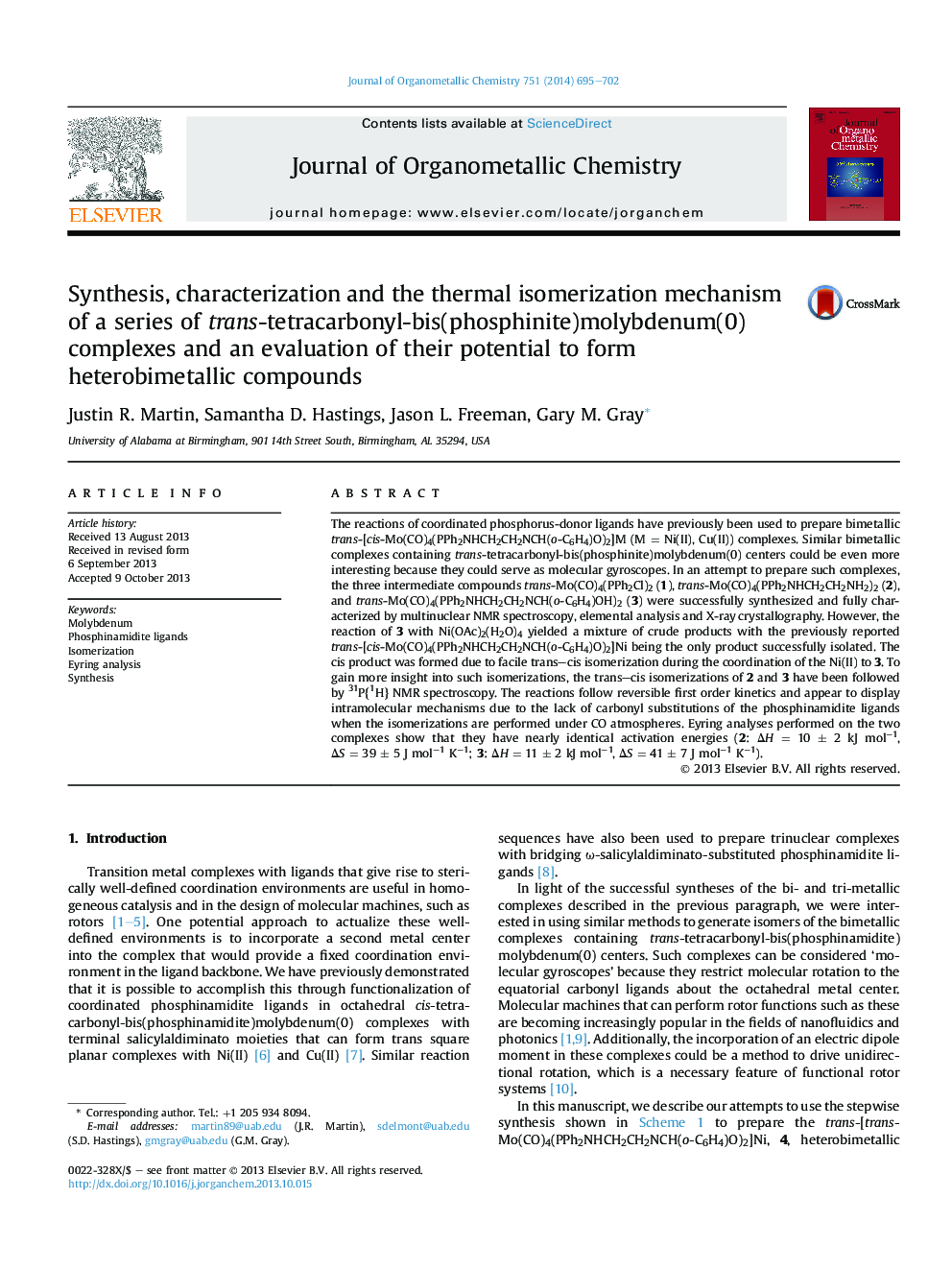| کد مقاله | کد نشریه | سال انتشار | مقاله انگلیسی | نسخه تمام متن |
|---|---|---|---|---|
| 1324330 | 1499889 | 2014 | 8 صفحه PDF | دانلود رایگان |
• Synthesis, multinuclear NMR spectroscopy and X-ray crystallography.
• Intramolecular metal (sp) carbonyl (π)–π interactions.
• Isomerization of octahedral molybdenum(0) phosphinamidite complexes.
• Reversible first-order isomerization kinetics and Eyring analyses.
• Carbonyl-ligand rearrangement involving a trigonal-prismatic transition state.
The reactions of coordinated phosphorus-donor ligands have previously been used to prepare bimetallic trans-[cis-Mo(CO)4(PPh2NHCH2CH2NCH(o-C6H4)O)2]M (M = Ni(II), Cu(II)) complexes. Similar bimetallic complexes containing trans-tetracarbonyl-bis(phosphinite)molybdenum(0) centers could be even more interesting because they could serve as molecular gyroscopes. In an attempt to prepare such complexes, the three intermediate compounds trans-Mo(CO)4(PPh2Cl)2 (1), trans-Mo(CO)4(PPh2NHCH2CH2NH2)2 (2), and trans-Mo(CO)4(PPh2NHCH2CH2NCH(o-C6H4)OH)2 (3) were successfully synthesized and fully characterized by multinuclear NMR spectroscopy, elemental analysis and X-ray crystallography. However, the reaction of 3 with Ni(OAc)2(H2O)4 yielded a mixture of crude products with the previously reported trans-[cis-Mo(CO)4(PPh2NHCH2CH2NCH(o-C6H4)O)2]Ni being the only product successfully isolated. The cis product was formed due to facile trans–cis isomerization during the coordination of the Ni(II) to 3. To gain more insight into such isomerizations, the trans–cis isomerizations of 2 and 3 have been followed by 31P{1H} NMR spectroscopy. The reactions follow reversible first order kinetics and appear to display intramolecular mechanisms due to the lack of carbonyl substitutions of the phosphinamidite ligands when the isomerizations are performed under CO atmospheres. Eyring analyses performed on the two complexes show that they have nearly identical activation energies (2: ΔH = 10 ± 2 kJ mol−1, ΔS = 39 ± 5 J mol−1 K−1; 3: ΔH = 11 ± 2 kJ mol−1, ΔS = 41 ± 7 J mol−1 K−1).
The synthesis, and multinuclear NMR spectroscopic and X-ray crystallographic of three trans-Mo(CO)4(PPh2X)2 (X = Cl, NH2CH2CH2R (R = NH2, NCHC6H4–4-OH)) complexes is described. Kinetic and thermodynamic studies of the phosphinamidite complexes have been carried out to provide insight into the trans–cis isomerization mechanism of these complexes.Figure optionsDownload as PowerPoint slide
Journal: Journal of Organometallic Chemistry - Volume 751, 1 February 2014, Pages 695–702
